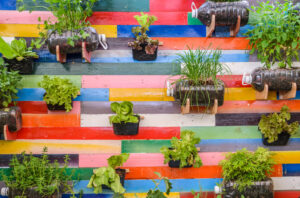Discover the joy of vertical gardening in cities! This beginner’s guide to vertical gardening shows you how to maximize space, grow fresh produce, and create a green oasis in your urban home.
Introduction
Ever dreamed of having a lush garden but thought your tiny apartment balcony made it impossible? Think again! Vertical gardening is revolutionizing urban spaces, and it’s easier than you might think. Did you know that vertical gardens can reduce indoor temperatures by up to 10 degrees Fahrenheit? That’s right – not only do they look amazing, but they’re functional too! In this guide, we’ll walk you through everything you need to know to start your own vertical garden, even if you’ve never wielded a trowel before. Get ready to transform your urban dwelling into a green paradise!
What is Vertical Gardening?
Definition and Basic Concepts of Vertical Gardening
Vertical gardening involves growing plants upward instead of outward, making the most of vertical space. This technique allows urban gardeners to cultivate a variety of plants in confined areas, such as apartment balconies, small patios, and even indoor spaces. By using wall-mounted planters, hanging baskets, and freestanding structures, you can create a thriving garden that defies spatial limitations.
Benefits for Urban Dwellers
Vertical gardening offers numerous benefits for city dwellers. Firstly, it saves space, enabling you to grow a green oasis in even the tiniest of areas. Secondly, vertical gardens contribute to air purification by filtering pollutants and increasing oxygen levels. Lastly, they add aesthetic appeal, transforming bland walls into vibrant, living artworks that bring nature into the urban environment.
Types of Vertical Gardens
There are several types of vertical gardens to consider. Wall-mounted gardens use structures like trellises or green walls to support plant growth. Freestanding vertical gardens, on the other hand, employ tiered planters or vertical towers that can be placed anywhere. Hanging gardens utilize suspended containers or baskets, making them ideal for window spaces or balconies with limited floor area.
Choosing the Perfect Location for Your Vertical Garden
Assessing Available Space
When selecting a location for your vertical garden, consider the available space. Balconies, walls, and windows are all viable options. Ensure that the chosen area receives sufficient natural light and is easily accessible for planting and maintenance.
Considering Light Requirements
Light is crucial for plant growth. Assess the light conditions in your chosen location, whether it’s full sun, partial shade, or low light. Choose plants that thrive in those specific conditions to ensure a healthy and vibrant garden.
Evaluating Weight-Bearing Capacity
Before setting up your vertical garden, evaluate the weight-bearing capacity of the structures you’ll use. Ensure that walls, railings, or other supports can safely hold the weight of the planters, soil, and fully grown plants without any risk of collapse or damage.
Essential Tools and Materials for Vertical Gardening
Containers and Planters
Choosing the right containers and planters is essential for a successful vertical garden. Opt for lightweight, durable options such as plastic, fabric, or wooden planters that are specifically designed for vertical setups. These containers should have proper drainage to prevent waterlogging and root rot.
Soil and Growing Medium
Selecting the appropriate soil or growing medium is crucial for plant health. Use a well-draining potting mix that retains moisture while allowing excess water to escape. You can also consider using lightweight soilless mixes, which are ideal for vertical gardens due to their excellent drainage properties.
Irrigation Systems and Watering Tools
Efficient watering is key to maintaining a thriving vertical garden. Drip irrigation systems or self-watering planters are excellent choices for ensuring consistent moisture levels. Additionally, invest in watering tools like watering cans, hoses with adjustable nozzles, or even automated timers to simplify the watering process.
Plant Supports and Trellises
To help your plants grow vertically, provide adequate support with trellises, stakes, or climbing grids. These structures will guide your plants’ upward growth, preventing them from sprawling and occupying unnecessary space. Choose materials that are sturdy and weather-resistant for long-lasting support.
Selecting Plants for Your Urban Vertical Garden
Best Plants for Beginners
For beginners, it’s best to start with plants that are easy to grow and care for. Herbs like basil, mint, and parsley are excellent choices, as they require minimal maintenance and thrive in small spaces. Leafy greens such as lettuce, spinach, and kale are also great options, providing a steady supply of fresh, nutritious produce.
Edible Options for Small Spaces
If you’re interested in growing your own food, consider edible plants that are well-suited for compact environments. Cherry tomatoes, peppers, and strawberries are ideal for vertical gardens, offering bountiful yields within limited space. Additionally, dwarf varieties of fruit trees, such as apples and lemons, can thrive in larger vertical setups.
Ornamental Plants to Enhance Aesthetics
To add visual appeal to your vertical garden, incorporate ornamental plants with vibrant colors and interesting textures. Flowering plants like petunias, marigolds, and nasturtiums can create stunning displays. Succulents and air plants are also excellent choices, as they require minimal care and can thrive in various lighting conditions.
Step-by-Step Guide to Setting Up Your First Vertical Garden
Preparing Your Space and Materials
Begin by preparing your chosen location. Clear the area of any clutter and ensure it is clean and level. Gather all necessary materials, including containers, soil, plants, and tools. Having everything ready will streamline the setup process and make it more efficient.
Installing the Vertical Structure or Containers
Next, install the vertical structure or containers according to your chosen design. Securely attach wall-mounted planters or trellises, assemble freestanding towers, or hang baskets from sturdy hooks. Ensure that all components are properly anchored to prevent accidents or damage.
Planting Techniques for Vertical Gardens
When planting your vertical garden, start by filling the containers with the appropriate growing medium. Gently remove plants from their nursery pots and place them in the containers, ensuring their roots are well-covered with soil. Space the plants evenly to allow for proper air circulation and growth.
Initial Care and Maintenance Tips
After planting, water your vertical garden thoroughly to settle the soil and hydrate the plants. Monitor the moisture levels regularly and adjust your watering schedule as needed. Provide adequate sunlight, prune any dead or damaged leaves, and fertilize the plants periodically to promote healthy growth.
Nurturing Your Vertical Garden Care and Maintenance
Watering Strategies for Vertical Setups
Watering vertical gardens can be challenging due to the potential for uneven distribution. Consider using drip irrigation systems or self-watering planters to ensure consistent moisture levels. Additionally, water the garden from the top, allowing excess water to trickle down and reach all plants.
Fertilizing and Feeding Your Plants
Regular feeding is essential for the health and productivity of your vertical garden. Use balanced, water-soluble fertilizers to provide essential nutrients. Follow the recommended dosage and frequency based on the specific needs of your plants. Organic options like compost tea or fish emulsion are also beneficial.
Pruning and Training Climbing Plants
To maintain a tidy and productive vertical garden, regularly prune and train climbing plants. Remove any dead or yellowing leaves and trim back excessive growth. Guide climbing vines along trellises or supports, securing them gently with garden ties or clips to encourage upward growth.
Pest Management in Urban Environments
Urban environments can pose unique challenges when it comes to pest management. Keep an eye out for common pests such as aphids, spider mites, and whiteflies. Implement natural pest control methods like introducing beneficial insects, using neem oil,or setting up sticky traps to manage infestations without harmful chemicals.
Overcoming Common Challenges in Vertical Gardening
Dealing with Limited Sunlight
One of the primary challenges in urban gardening is limited sunlight. If your vertical garden gets fewer than six hours of direct sunlight, choose shade-tolerant plants such as ferns, ivy, and specific herbs. To further support your plants, consider using reflective surfaces or grow lights to supplement natural light, ensuring they thrive.
Managing Water Runoff and Drainage
Proper water management is crucial in vertical gardens to prevent waterlogging and root rot. Ensure that your containers have adequate drainage holes to allow excess water to escape. Place saucers or trays beneath the containers to catch runoff and prevent water from damaging surfaces or causing mold growth.
Preventing Soil Erosion in Vertical Setups
In vertical gardens, soil erosion can occur due to the force of gravity and water flow. To prevent this, use lightweight growing mediums that retain moisture while providing stability. Additionally, consider adding a layer of mulch on top of the soil to protect it from erosion and help retain moisture.
Adapting to Seasonal Changes
Urban gardeners must adapt their vertical gardens to seasonal changes. In colder months, protect your plants from frost by covering them with frost cloth or moving them indoors. During hot summers, provide shade using umbrellas or shade cloth to prevent sunburn and dehydration.
Creative DIY Vertical Garden Ideas for Small Spaces
Pallet Gardens for Balconies
Repurposing wooden pallets is a fantastic way to create a vertical garden for your balcony. Simply attach small pots or fabric pockets to the pallet slats and fill them with your favorite plants. Lean the pallet against a wall or secure it to a railing for a charming and space-saving garden.
Hanging Bottle Gardens for Windows
Transform empty plastic bottles into hanging planters for your windows. Cut the bottles in half, fill them with soil, and plant herbs or small flowers. Hang the bottles using strings or hooks, creating a whimsical and functional garden that maximizes vertical space.

Vertical Herb Spirals for Tiny Patios
Herb spirals are a creative and efficient way to grow a variety of herbs in a small area. Construct a spiral-shaped garden bed using stones or bricks, filling it with soil as you build. Plant different herbs at varying levels of the spiral, allowing each plant to receive optimal sunlight and drainage.
Repurposed Shoe Organizers as Plant Holders
Old shoe organizers can be repurposed into unique vertical gardens. Hang the organizer on a wall or fence and fill each pocket with soil and plants. This method works particularly well for growing herbs, small vegetables, or trailing plants, creating a visually appealing and space-efficient garden.
Conclusion
There you have it – your roadmap to creating a thriving vertical garden in the heart of the city! With these tips and tricks up your sleeve, you’re well on your way to transforming your urban space into a green haven. Remember, gardening is a journey, so don’t be afraid to experiment and learn as you grow. Whether you’re looking to cultivate your own fresh herbs, create a living wall of succulents, or simply add a touch of nature to your concrete jungle, vertical gardening opens up a world of possibilities. So, what are you waiting for? Grab those gardening gloves, and let’s get growing! Your urban oasis awaits, and trust me, once you see those first green shoots, you’ll be hooked. Happy gardening, city dweller!

